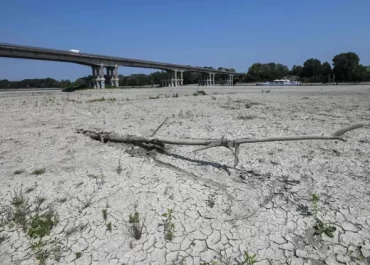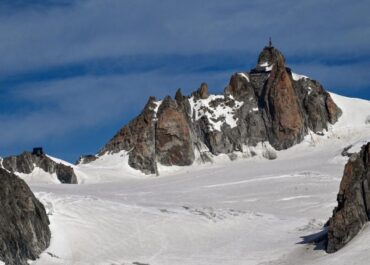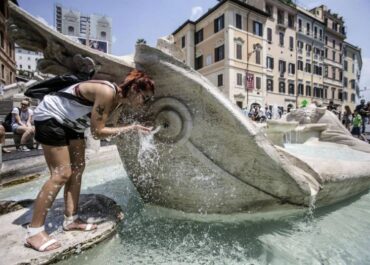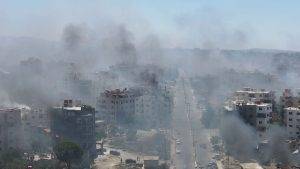- Complete Schedule of DWP Christmas 2025 Payment Dates
- Teen Dies Following Car Flip in Baildon Accident
- Poppers and condoms discovered in bathroom post-Andrew’s Sandringham bash
- Massive blaze at Methil Harbour: Several lorries in flames
- Hero neighbor rescues family just before home engulfed in flames
- Family grieves motorcyclist lost in collision with van | UK News
- UK to ban puppy farms and trail hunting in major animal welfare reform
- Prison Brawl Involves Stephen Lawrence’s Killer and Manchester Bomber
Europe heatwave: Italy declares state of emergency
Quick Summary
- Italy has declared a state of emergency for five northern Italian regions – Friuli-Romagna, Friuli-Venezia Giulia, Lombardy, Piedmont and Veneto, lasting until December 31.
- 36.5 million euros in emergency funding has been announced to help ease the effects of the drought.
- Italy is experiencing an early heatwave and a lack of rainfall.
- Water restrictions and weather red alerts are in place.
Analysis
Drought-stricken Italy declares state of emergency
A state of emergency has been declared in five northern Italian regions – Friuli-Romagna, Friuli-Venezia Giulia, Lombardy, Piedmont and Veneto, lasting until December 31. Italy also announced emergency funds of 36.5 million-euro to help those affected by the worsening drought that has plagued the Po Valley in recent weeks.
With an early heatwave and a lack of rainfall, Italy’s northern agricultural Po Valley has been hit by its worst drought in 70 years.
Water levels drop, drinking water restricted
A state of emergency provides “extraordinary means and powers” and will support public safety and compensation for losses. It will also help guarantee normal living conditions for those in the area.
Italy’s largest agricultural union, Coldiretti says the drought threatens more than 30 per cent of national agricultural production and half of the farms in the Po Valley, where Parma ham is produced.

Lake water levels have also taken a dip, with Lakes Maggiore and Garda having lower than normal levels for this time of the year, while further south the Tiber River, which runs through Rome, has also dropped.
The Po is the peninsula’s largest water reservoir, much of which is used by farmers to irrigate rice paddies, farm fields and grazing land for cows.
Over the past few days, municipalities have announced restrictions – including on drinking water.
The city of Verona has rationed the use of drinking water, while Milan has closed its decorative fountains.
The drought has also hit hydroelectric power production.
The Hydroelectric plants, which are mostly in the mountainous north of Italy, account for nearly 20 per cent of national energy production.
Glacier collapse that killed 7, linked to global warming
The announcement comes just one day after at least seven people died after a glacier collapsed in the Italian Alps which Prime Minister Mario Draghi said was “without doubt” linked to global warming.
On Sunday afternoon, a large chunk of Alpine glacier broke loose and slid down a mountainside, crashing into hikers on a popular trail on the peak. At least four people have been killed and 7 injured, according to Italian state television.
The section that broke away is known as a serac, or pinnacle of a glacier.

“A breaking away of rock provoked the opening of a crevasse on the glacier, leaving about 15 people involved,” the emergency dispatchers tweeted.
The intense heatwave gripping Italy since late June is likely a factor in the ice breaking away, Walter Milan, an Alpine rescue service spokesperson told RAI state TV.
“The heat is unusual,” Milan said, noting that temperatures in recent days on the peak had topped 10 C (50 F). ”That’s extreme heat” for the peak, Milan said. “Clearly it’s something abnormal.”
Italy heatwave 2022
Caronte (Charon), the subtropical anticyclone that has been pushing temperatures across Italy well above average for over a week now, shows no sign of easing off just yet.

Most Italian cities are currently under a red alert – a response to critical weather conditions that are regarded as a serious threat to the health of the entire population and not just the vulnerable.
How long will Italy’s current heatwave last?
So how long will Italians have to put up with the current heatwave? According to the latest forecasts, anticyclone Caronte should begin retreating from the country from Wednesday 6 July. Temperatures in line with the season average should return in the northern regions first and then in the rest of the peninsula over the following 48 hours.
These unprecedented heatwaves are expected to become more and more frequent in the future. According to Antonello Pasini, a leading physicist at the CNR (National Research Council), the drastic climate change crisis means that most Italians will be forced to endure summers with “temperatures far above average” in the coming years.
How long will Italy’s drought last?
The drought shows little sign of easing, the summer is forecast to be hot with continued little rainfall and it is expected the water level of the Po River will continue to drop.
Restrictions coming into place now and over the next few weeks will likely remain in place until the end of the summer.
Travel advice for Italy’s water bans
At the time of writing, there are no restrictions on visiting Italy as a result of the drought, but if you’re planning a trip to the country you should look out for emergency measures such as water rationing.
In Verona and Pisa, drinking water can’t be used for watering vegetable patches, gardens and sports fields, for washing cars, filling swimming pools or for any activity not strictly necessary for human needs. Rationing will remain in place until 31 August and people found to be breaking the restrictions could be fined up to €500.
In Villorba, a municipality in the Veneto region, residents are not allowed to water gardens, wash cars or fill swimming pools between 6 am and 11 pm. The ban is in place until 30th September.
Some councils are evaluating restrictions on water use for water parks and could see amusement parks using filtered seawater at attractions near the coast, whilst other parks may be forced to close.
Rome’s emergency measures may see public drinking fountains turned off, as occurred during a drought in 2017.
How safe is it to travel in Italy?
Italy is a hugely popular holiday destination, with nearly 60 million tourists travelling within its borders each year. In terms of safety, Italy is a mostly safe place to travel, with tourist infrastructure and essential services readily available if anything goes wrong.
What is Italy known for?
Italy is famous for the Renaissance and the incredible artists it produced. Italy is famous for its tourism, its art cities and unique scenery. Italy is also known for its language, its opera, its fashion and its luxury brands. It is also known for its football team!

Homes still burning after mass pillaging and 30,000 trapped in besieged city as Syria’s fragile ceasefire holds
Read More »Like this article?
News Team
Leave a comment
Subscribe to Updates
Get the latest creative news from FooBar about art, design and business.




